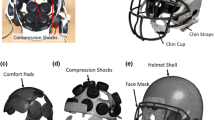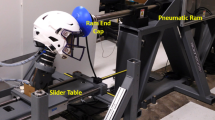Abstract
This study compares drop tower tests of four commonly used football helmets, under the National Operating Committee on Standards for Athletic Equipment (NOCSAE) football helmet standard, to show that the tests need modification to include the facemask. In our study, the need for a more robust systematic approach to football helmet testing procedures is emphasized by comparing the Head Injury Criterion (HIC), the Gadd Severity Index (SI), and peak acceleration values for different helmets at different locations on the helmet under modified NOCSAE standard drop tower tests. Drop tests were performed on four modern football helmets at eight impact locations (front, front boss, side, rear, rear boss, top, front top, and front top boss), two different impact velocities (5.46 and 4.88 m/s), and two helmet configurations (“with facemasks” and “without facemasks”). Statistically significant differences (p < 0.05) were found in 41% of the comparisons between “with facemasks” and “without facemasks”. Addition of the facemask resulted in an increased HIC, SI, and peak acceleration response measures in 62% of these cases. For example, the stiffening boundary conditions arising from the attached facemask can decrease the helmet performance by up to 50% depending on the impact location when considering the peak acceleration (p < 0.001) as a metric. In terms of location, the top and front top impacts gave the largest HIC, SI, and peak acceleration values. In summary, these comparative drop test results revealed that the current NOCSAE test methods need improvement by attaching the facemasks to helmets and by including two new helmet impact locations (front top and front top boss). The modified NOCSAE football helmet standard test gives a more accurate representation of a helmet’s performance and its ability to mitigate on-field impact.





Similar content being viewed by others
References
Langlois JA, Rutland-Brown W, Wald MM (2006) The epidemiology and impact of traumatic brain injury: a brief overview. Lippincott Williams & Wilkins
Broglio SP et al (2009) Head impacts during high school football: a biomechanical assessment. J. Athl Train 44(4):342–349
Broglio SP et al (2013) Estimation of head impact exposure in high school football: implications for regulating contact practices. Am J Sports Med 41(12):2877–2884
Costanza A et al (2011) Review: contact sport-related chronic traumatic encephalopathy in the elderly: clinical expression and structural substrates. Neuropathol Appl Neurobiol 37(6):570–584
Prevention, C.f.D.C.a., Nonfatal Traumatic Brain Injuries Related to Sports and Recreation Activities Among Persons Aged <=19 Years - United States, 2001-2009. Morbidity and Mortality Weekly Report, 2011. 60(39)
Viano DC, Withnall C, Halstead D (2012) Impact performance of modern football helmets. Ann Biomed Eng 40(1):160–174
Bartsch A et al (2012) Impact test comparisons of 20th and 21st century American football helmets: laboratory investigation. J Neurosurg 116(1):222–233
Greenwald RM, Gwin JT, Chu JJ, Crisco JJ (2008) Head impact severity measures for evaluating mild traumatic brain injury risk exposure. Neurosurgery 62(4):789–798
Lissner HR (1960) Experimental studies on the relation between acceleration and intracranial pressure changes in man`. Surg Gynecol Obsterics III:329–338
Gurdjian ESEA (1963) Concussion—mechanism and pathology. Proceedings of the Seventh Strapp Car Crash Conference
Patrick LMEA (1963) Survival by design—head protection. The Seventh Strapp Car Crash Conference
Gadd CW (1966) Use of a weighted-impulse criterion for estimating injury hazard. SAE Technical Papers
Versace J (1971) A review of the severity index. SAE Technical Papers
Newman JA, Shewchenko N, Welbourne E (2000) A proposed new biomechanical head injury assessment function—the maximum power index. Stapp Car Crash J 44:215–247
Rowson S, Duma SM (2011) Development of the STAR evaluation system for football helmets: integrating player head impact exposure and risk of concussion. Entwicklung des STAR-Messsystems zur Beurteilung der Schutzfunktion von Football-Helmen hinsichtlich Kopfverletzung und Gehirnerschütterung 8:2130
NOCSAE (2013) Statement from the National Operating Committee on Standards for Athletic Equipment Regarding 2013 Virginia Tech Star Rating System. NOCSAE News
NOCSAE (2013) NOCSEA overview
NOCSAE (2011) Standard performance specification for newly maufactured football helmets. Paper No. 002-11m11a
Gwin JT et al. (2010) An investigation of the NOCSAE linear impactor test method based on in vivo measures of head impact acceleration in American football. Journal of Biomechanical Eng 132(1)
NOCSAE (2013) NOCSAE standards and process
NOCSAE (2011) Standard Method of Impact Test and Performance Requirements for Football Faceguards. Paper No. ND087-11M11
NOCSAE (2012) Standard performance specification for newly manufactured lacrosse Helmets with Faceguard. NOCSAE DOC (ND) 041-11m12
Hodgson VR, Thomas LM, Prasad P (1970) Testing the validity and limitations of the severity index. SAE Technical Papers
Newman J et al. (2000) A new biomechanical assessment of mild traumatic brain injury. Part 2. Results and conclusions. Proceedings of International Research Conference on the Biomechanics of Impacts, pp 223–233
Pellman EJ et al (2003) Concussion in professional football. Reconstruction of game impacts and injuries. Neurosurgery 53(4):799–814
Xenith (2011) X2 Player’s manual
Schutt (2009) Schutt helmet fitting instructions
Schutt (2009) ION 4D Faceguard attachment instructions. 2009
Rawlings, NRG Quantum fit guide
Riddell, 360 fitting instructions and helmet care
Acknowledgements
The authors would like to thank the Center for Advanced Vehicular Systems (CAVS) at Mississippi State University for supporting this work. G. Alston Rush would also like to thank Rush Sports Medicine for their support.
Author information
Authors and Affiliations
Corresponding author
Rights and permissions
About this article
Cite this article
Rush, G.A., Rush, G.A., Sbravati, N. et al. Comparison of shell-facemask responses in American football helmets during NOCSAE drop tests. Sports Eng 20, 199–211 (2017). https://doi.org/10.1007/s12283-017-0233-2
Published:
Issue Date:
DOI: https://doi.org/10.1007/s12283-017-0233-2




